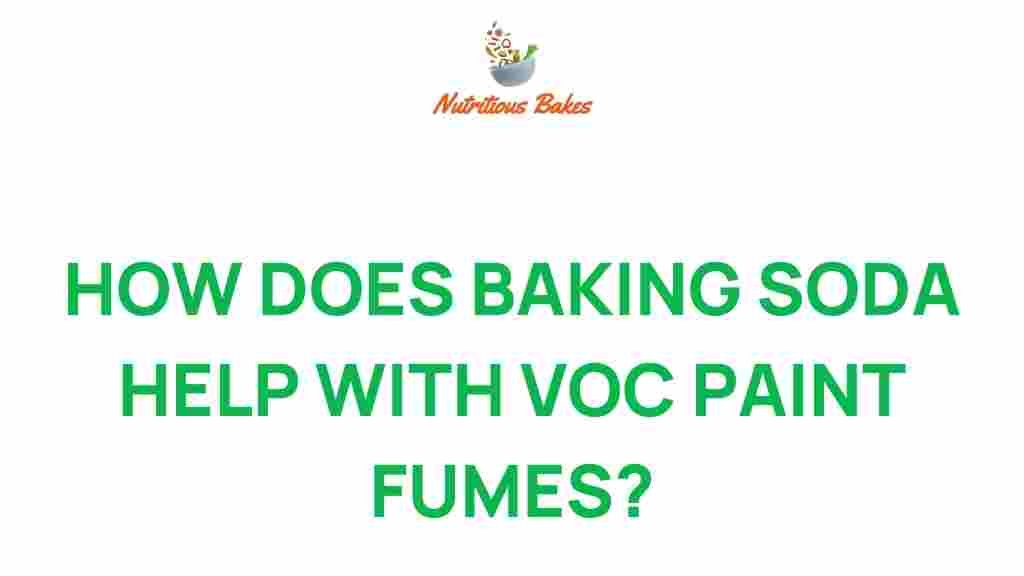The Surprising Role of Baking Soda in Neutralizing VOC Paint Fumes
When it comes to home improvement projects, painting is one of the most common tasks that homeowners undertake. However, many paints release volatile organic compounds (VOCs) into the air, which can lead to unpleasant paint fumes and poor indoor air quality. Fortunately, there are natural remedies available, and one surprisingly effective option is baking soda. In this article, we will explore how baking soda can help neutralize VOC paint fumes, improve indoor air quality, and provide practical DIY tips for safe home improvement.
Understanding VOCs and Paint Fumes
Volatile organic compounds (VOCs) are organic chemicals that have a high vapor pressure at room temperature. They are commonly found in many household products, including paints, varnishes, and cleaning supplies. VOCs evaporate quickly, which is why they are often the source of strong odors when painting.
Exposure to VOCs can lead to various health issues, including headaches, dizziness, and respiratory problems. Therefore, maintaining good indoor air quality during and after painting is crucial for your health and safety.
The Benefits of Baking Soda
Baking soda, or sodium bicarbonate, is a versatile substance commonly found in kitchens. Beyond its culinary uses, baking soda has remarkable properties that make it an effective natural remedy for neutralizing odors, including those from VOC paint fumes. Here are some reasons why baking soda is a great choice:
- Odor Neutralization: Baking soda absorbs odors, making it ideal for combatting the smell of paint fumes.
- Non-Toxic: Unlike many commercial air fresheners, baking soda is safe for indoor use and poses no health risks.
- Cost-Effective: Baking soda is inexpensive and readily available at grocery stores.
- Versatile: It can be used in various applications beyond just paint fumes.
How to Use Baking Soda to Neutralize VOC Paint Fumes
Using baking soda to combat VOC paint fumes is straightforward and can be done in just a few steps. Below is a step-by-step guide to help you effectively neutralize these harmful fumes in your home.
Step 1: Prepare Your Space
Before you begin painting, it’s essential to prepare your space to minimize the impact of VOCs:
- Ensure good ventilation by opening windows and using fans to circulate air.
- Remove any furniture or items that may absorb paint odors.
- Consider using low-VOC or zero-VOC paint options to reduce the emission of harmful fumes.
Step 2: Create Baking Soda Solutions
There are various ways to use baking soda to neutralize paint fumes:
- Bowls of Baking Soda: Place open bowls of baking soda around the room. The baking soda will absorb the paint fumes over time.
- Baking Soda Paste: Mix baking soda with water to create a paste. Apply this paste to surfaces that may have absorbed paint odors, such as walls or furniture.
- Baking Soda Spray: Dissolve a few tablespoons of baking soda in water and use a spray bottle to mist the air in the room.
Step 3: Allow Time for Absorption
Once you’ve set up your baking soda solutions, give them time to work. It may take several hours or even days for the baking soda to fully neutralize the paint fumes, depending on the size of the area and the intensity of the odors.
Step 4: Maintain Air Quality
To ensure ongoing air quality improvement, consider the following:
- Continue to ventilate the area by opening windows and using fans.
- Replace bowls of baking soda every few days for maximum effectiveness.
- Consider using additional natural remedies, such as activated charcoal or essential oils, alongside baking soda.
Troubleshooting and Tips
While baking soda is a powerful tool, you may encounter challenges when trying to neutralize VOC paint fumes. Here are some troubleshooting tips:
- Persistent Odors: If the paint fumes remain strong after several days, consider increasing the amount of baking soda used or adding more ventilation.
- Allergic Reactions: If you or anyone in your home has sensitivities or allergies, monitor for any reactions and discontinue use if necessary.
- Mixing with Other Remedies: Baking soda can be combined with other natural remedies for enhanced effectiveness. For example, vinegar can also help neutralize odors, but be sure to use them separately.
Additional Indoor Safety Tips
Improving air quality during home improvement projects is essential. Here are some additional indoor safety tips:
- Use masks designed to filter out VOCs when painting.
- Limit exposure by taking breaks outside if the fumes become overwhelming.
- Read labels on paint products to choose those with low or zero VOCs.
Conclusion
As we’ve explored, baking soda plays a surprisingly effective role in neutralizing VOC paint fumes, making it an excellent natural remedy for improving indoor air quality during home improvement projects. By understanding how to use baking soda properly and taking additional safety measures, you can ensure a safer painting experience. For more DIY tips and insights on indoor safety, be sure to check out our home improvement guide.
Remember, maintaining good air quality is crucial for your health, especially during and after painting. With these simple strategies, you can enjoy a fresh and safe indoor environment.
For further reading and resources on VOCs and their effects, visit the Environmental Protection Agency’s website.
This article is in the category Tips and created by NutritiousBakes Team
